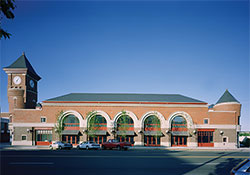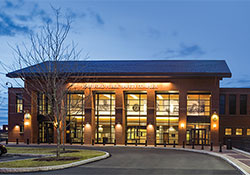
Peter Stevens, M.A.’83
Blueprint for Success
By Carol Olechowski
University at Albany master’s degree in criminal justice helped Peter Stevens draw up a blueprint for success in the architecture field.
Stevens is president of JCJ Architecture, a prestigious firm founded in 1936. From its headquarters in Hartford, Conn., and offices in New York, Boston, Phoenix and San Diego, JCJ provides planning and design services for a wide range of justice, hospitality, education, civic and corporate projects in the United States, Latin America and the Middle East.

JCJ Architecture incorporated separate retail and restaurant space into its design for the Middletown, Conn., police headquarters.
At Bates College, Stevens prepared for a vocation in urban ministry. His calling took an unexpected turn when he spent his junior year in Sweden, observing the country’s correctional system, including Kumla, its “most secure and largest prison.” Stevens noticed that inmates were required “to work in meaningful jobs, both inside and outside the prison”; pay taxes; and support their dependents. Physical environment, family and conjugal visitations, and personal interaction between inmates and correctional staff promoted “a restorative approach” to inmate rehabilitation.
By contrast, “prison industries in the U.S. weren’t real industries and didn’t really provide vocational training. They made license plates and cheap furniture. Most inmates were idle, not focused on creating a better outcome after release.”
After graduation, Stevens headed an educational program for challenged Appalachian children and became a regular visitor at Alderson Women’s Penitentiary in West Virginia. Later at Albany, while taking classes with professors Hans Toch and David Duffee, he “began to put the pieces together and understand what I had observed at the only women’s federal prison in the U.S.”

JCJ’s Hartford Public Safety Complex design promotes “community use and positive
interaction between the police and the public,” says the firm’s president, Peter Stevens.
At Hindelang Center, Stevens assisted in a research project “with some of my mentors, including Kathleen Heide [M.A.’78, Ph.D.’82, now a professor of criminology at the University of South Florida].”
Stevens intended to pursue doctoral studies in criminal justice at UAlbany, but the Comprehensive Crime Control Act enacted in the 1980s impacted all aspects of the federal justice system and “affected my immediate plans.” He secured a part-time position as a criminal-justice planner at The Ehrenkrantz Group in New York City and, for several months simultaneously, had a part-time research-associate’s role at the Hartford Institute of Criminal and Social Justice. Stevens later worked for Rosser International until joining JCJ Architecture in 1988.
Though Stevens is not an architect, he notes: “What I learned at Albany gave me a certain insight into the built environment that was not part of traditional architectural training. I enjoy addressing the corrections, judicial or public-safety issues that relate to the operational components of justice facilities. Many can lead to life-or-death situations.”
Stevens favors a direct-supervision approach to correctional management. “A less-institutional environment is more rehabilitative; it depends on the human eye and contact for oversight and communication, and to prevent situations from escalating. In contrast, indirect supervision is very custodial, relying on cameras, mouthpieces and intercom systems. There’s much less direct contact between officers and inmates.”
JCJ designs incorporate elements that will “act as catalysts for sustainable development” and advance community integration, explains Stevens. One example, the police headquarters in Middletown, Conn., provides “almost a mixed-use development, with separate space for retail and restaurant operations. Locating a facility in the heart of a community and providing community-use spaces helps to erase the arbitrary lines between local residents and their public servants,
promoting positive interaction between the police and the public.
"What I learned at Albany gave me a certain insight into the built environment that was not part of traditional architectural training."
“The incredible range of our project experience and sensitivity to design has enabled us to develop a unique position in our industry,” Stevens adds. Recent high-profile projects include renovations of Lincoln Center’s David H. Koch Theater and the Empire State Building Observatory; adaptation of historic Aqueduct Raceway into Resorts World New York; and design services for two Navajo Nation restorative-justice complexes in Arizona and New Mexico. JCJ Architecture has worked extensively with more than 40 Native American tribes, helping their communities “to meet their economic and self-determination goals,” says Stevens.
Design That Builds Community, JCJ’s mission statement, “drives us in our work and in our relationships with one another,” observes the third-generation Hartford native, whose family includes wife Sarah and children Matt and Julie. The firm’s emphasis on “personal and corporate involvement with the community” benefits such organizations as Habitat for Humanity, the Boys & Girls Clubs, YMCA, Connecticut FoodShare and the University of Hartford. Stevens himself, a board member of Watkinson School and the New Children’s Museum, also chairs the City of Hartford’s Pension Commission.
In 2011, “after 75 years of tightly controlled private ownership, JCJ Architecture became a 100-percent employee-owned business. We still have a board of directors,” Stevens says, “but now we have 122 owners. It’s very exciting to break ground on such a dynamic model.”
- UAlbany Magazine
Spring 2013 - Cover Story
- Features
- Departments
- The Carillon
- Past Issues





